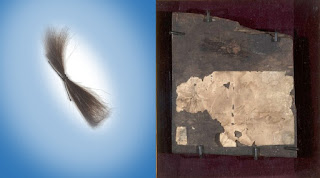Poe vs. “The Conqueror Worm”
 |
| A lock of hair from Poe’s burial (l.); a fragment of his coffin (r.) |
One hundred and seventy years ago, on October 9, 1849, Edgar Allan Poe was buried in the Westminster Hall and Burying Ground in Baltimore, two days after his unexpected death. Less than ten mourners attended the rained out ritual, which seemed to confirm the conviction expressed by Poe in one of his poems, “The Conqueror Worm” (1843), which posits that human life is a meaningless absurdity and that the worms that feast on human remains triumph over our very existence:
That the play is the tragedy,
“Man,”
And its hero, the Conqueror Worm.
[Listen to the audio of my recitation of the poem at the foot of this post.]
Poe’s poem is gloomy, dismal,
fatalistic. It projects itself over some apocalyptic future, “the lonesome
latter years” in which humanity seems to have been extinguished. The only “gala”
in this bleak epoch involves “an angel throng”—as there appear to be no
humans to be found. In Poe’s curious eschatology, these angels are the jury
that sits in judgment over cosmic history, and they appear to have jurisdiction
not only over human events, but over divine action, like theater critics
evaluating a dramatic performance, while a cosmic orchestra plays the musica
universalis—the inaudible sound of the stars and planets in motion.
The interplay of the Titans with the
mortals on the divine stage described by Poe has a Gnostic touch: the visible
deities are but “Mimes, in the form of God on high,” actually controlled,
through puppet strings, by an unseen hand. Just as in Gnosticism, the Creator-God
is an inferior deity (the Demiurge) who acts with the lesser Aeons, but the
true God is unseen, so these gods are “mere puppets … who come and go/At bidding
of vast formless things/That shift the scenery to and fro.”
The theatrical performance features
a “motley drama” intended to portray the human condition. In this
mini-play, a “phantom” or villain is pursued in a circular chase but
never apprehended. It is theater of the absurd, with a circular, repetitive plot
structure, serving simply to point out the meaninglessness of its
operation. The “phantom” is a
foil, representing a distraction that keeps us from understanding true
reality. It makes our life, as Poe would
say elsewhere, “A dream within a dream.”
But, in the middle of these empty
devices, a single, hard reality imposes itself:
But see, amid the
mimic rout
A crawling shape intrude!
A blood-red thing
that writhes from out
The scenic solitude!
Everything around is meaningless
and illusory, but the monstrous “vermin” invades the stage and begins tearing
up the scene, like Pacman eating up the ghosts in his Atari techno maze. Poe describes
the gory scene to drive home the point that the carnage is real: “the mimes
become its food,/And the angels sob at vermin fangs/In human gore imbued.”
The angels, noble creatures, despite
their disembodied aloofness, withdraw from the theater, “pallid and wan,” and render their judgment:
That the play is the
tragedy “Man,”
And its hero the
Conqueror Worm.
If the Conqueror Worm triumphed on
October 9, 1849, when Edgar Allan Poe was originally laid to rest, its victory
was short-lived. A quarter century later, on November 17, 1875, Poe had reached
such renown that his remains were exhumed and re-interred under a more fitting
monument. Other famous writers sent messages for the occasion and Walt Whitman was
present in person to behold a new “play of hopes and fears.” This time, in
the “motley drama,” the angels did not stay on the sidelines, but seemed to intervene in human affairs.




Comments
Post a Comment